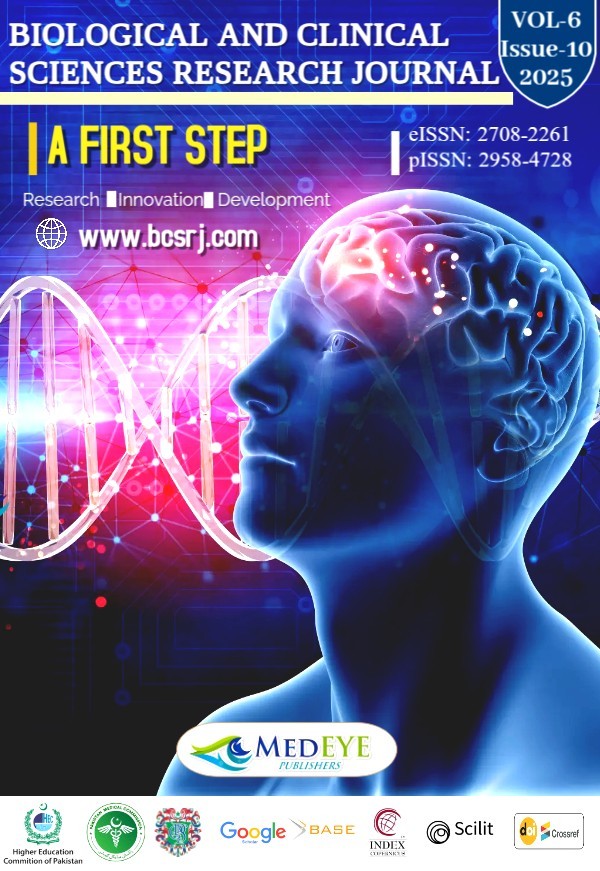From Hive to Hope: Honeybee and Apiculture Derived Products in Pakistan
DOI:
https://doi.org/10.54112/bcsrj.v6i10.2037Keywords:
Apiculture, Biodiversity, Conservation, Honeybee, PollinationAbstract
Honeybees are vital for pollination, biodiversity, and the production of apicultural products. Their populations, however, are increasingly threatened by various environmental and biological stressors in Pakistan. Strengthening knowledge on their ecological and economic roles is crucial for sustainable conservation. Objective: To synthesize current evidence on honeybee species, apiculture development, economic potential of bee products, and the major threats to honeybee populations in Pakistan. Methods: This narrative review examined published literature, government reports, and apiculture data relevant to Pakistan. Sources were identified from major scientific databases and national records, with no time restrictions. Information on honeybee species distribution, apiculture production, export trends, and threats was extracted and descriptively analyzed to provide an updated overview for researchers and policymakers. Results: Pakistan hosts four honeybee species, with Apis mellifera being the predominant domesticated species. Despite growth in the apiculture sector, average honey yield remains below 12 kg per beekeeper, nearly half of the global average. Honey, pollen, propolis, beeswax, and royal jelly are produced, although honey remains the major export at approximately five million kilograms annually. Diverse biotic and abiotic pressures are causing significant declines in both wild and managed populations, while national data remain insufficient for informed conservation planning. Conclusion: Honeybees in Pakistan hold considerable ecological and economic value, yet their populations face multiple challenges that are inadequately documented. Strengthening research capacity, improving apicultural practices, and establishing targeted conservation strategies are essential to protecting honeybee diversity and ensuring sustainable resource use.
Downloads
References
Akça R. and SARUHAN İ.. The effects of some insecticides on honeybees (Apis mellifera). Israel Journal of Ecology and Evolution 2022;69(1-2):37-43. https://doi.org/10.1163/22244662-bja10043
Barbisan L. and Riente F. Machine learning framework for the acoustic detection of the queen bee presence. 2024:4347-4350. https://doi.org/10.61782/fa.2023.1309
Covaci M., Covaci B., & Selma C. Apis mellifera honey: healing effects - a value chain view from mountain agriculture. International Journal of Ayurvedic Medicine 2024;15(2):452-456. https://doi.org/10.47552/ijam.v15i2.4616
Sarı F. and Koyuncu F. Land use change assesment for beekeeping in southeast Anatolia. Uludağ Arıcılık Dergisi 2020;20(1):51-61. https://doi.org/10.31467/uluaricilik.684608
Algethami J., El‐Wahed A., Elashal M., Ahmed H., Elshafiey E., Omar E., et al.. Bee pollen: clinical trials and patent applications. Nutrients 2022;14(14):2858. https://doi.org/10.3390/nu14142858
Sewando P.. The potential of beekeeping activities to enhance local livelihoods and climate change adaptation in semi-arid areas of Tanzania. Journal of Agriculture and Ecology Research International 2023;24(2):46-54. https://doi.org/10.9734/jaeri/2023/v24i2525
Bava R., Castagna F., Musella V., Lupia C., Palma E., & Britti D. Therapeutic use of bee venom and potential applications in veterinary medicine. Veterinary Sciences 2023;10(2):119. https://doi.org/10.3390/vetsci10020119
Sevin S., Özkan A., Tutun H., Kıvrak İ., Turna Ö., & Eskiler G. Determination of the effects of bee venom on triple negative breast cancer cells in vitro. Chemistry & Biodiversity 2023;20(3). https://doi.org/10.1002/cbdv.202201263
Dezmirean D., Pașca C., Moise A., & Bobiş O. Plant sources responsible for the chemical composition and main bioactive properties of poplar-type propolis. Plants 2020;10(1):22. https://doi.org/10.3390/plants10010022
Yosri N., El‐Wahed A., Ghonaim R., Khattab O., Sabry A., Ibrahim M.et al.. Anti-viral and immunomodulatory properties of propolis: chemical diversity, pharmacological properties, preclinical and clinical applications, and in silico potential against SARS-CoV-2. Foods 2021;10(8):1776. https://doi.org/10.3390/foods10081776
Bouzahouane H., Ayari A., Guehria I., & Riah O. Propolis: antimicrobial activity and chemical composition analysis. Journal of Microbiology Biotechnology and Food Sciences 2021;10(6):e3211. https://doi.org/10.15414/jmbfs.3211
Rezvannejad E., Nasirifar E., Lotfi S., & Abdoli-Nasab M. Study and comparison of antibacterial activities of extracts of zataria multiflora and teucrium polium on penibacillus alvei. Journal of the Hellenic Veterinary Medical Society 2019;70(1):1421. https://doi.org/10.12681/jhvms.20350
Romero‐Márquez J., Navarro‐Hortal M., Varela‐López A., Osta S., Zabaleta M., Rivas-García L., et al Usefulness of beeswax recycling by-products in the treatment of β-amyloid toxicity in a c. elegans Model of alzheimer. Mediterranean Journal of Nutrition and Metabolism 2020;13(2):163-173. https://doi.org/10.3233/mnm-200404
Aylanç V., Falcão S., Ertosun S., & Vilas‐Boas M.. From the hive to the table: nutrition value, digestibility, and bioavailability of the dietary phytochemicals present in the bee pollen and bee bread. Trends in Food Science & Technology 2021;109:464-481. https://doi.org/10.1016/j.tifs.2021.01.042
Mirjanić G., Mihajlović D., & Bosančić B.. Significance of the apiary location for the content of copper and zinc in the bee pollen. Агрознање 2024;25(1). https://doi.org/10.7251/agren2401001m
Atta D., Rashed R., & Hassan S.honey and royal jelly boost sperm parameters, ovarian follicles growth, and steroid hormones in immature rats. Open Veterinary Journal 2025;15(6):2573. https://doi.org/10.5455/ovj.2025.v15.i6.29
Agboola I., George-Onaho J., Ete J., & Ayandokun A. Contribution of apiculture in social and economic development of Nigeria. Journal of Applied Sciences and Environmental Management 2021;25(9):1559-1562. https://doi.org/10.4314/jasem.v25i9.2
Shah R., MAAWALI A., & RAEESI A. Comparative toxicity of two neonicotinoids and a pyrethroid to forager honeybees (Apis mellifera L., 1758) (Hymenoptera: Apidae) by different exposure methods. Turkish Journal of Entomology 2020:111-121. https://doi.org/10.16970/entoted.619263
Ribeiro H., Correia R., Moreira T., Boas D., Azeredo J., & Oliveira A. Bacteriophage biodistribution and infectivity from honeybee to bee larvae using a T7 phage Model. Scientific Reports 2019;9(1). https://doi.org/10.1038/s41598-018-36432-x
Abdelkader S., Abdel–Lateef M., Abdelmonem A., & Yousif A. Effect of sub-lethal doses of clothianidin and spinosad insecticides on honeybee larvae. Al-Azhar Journal of Agricultural Research 2021;46(2):182-190. https://doi.org/10.21608/ajar.2021.245648
Phokasem P., Mookhploy W., Krongdang S., Sinpoo C., & Chantawannakul P. Interaction between thiamethoxam and deformed wing virus type A on wing characteristics and expression of immune and apoptosis genes in Apis mellifera. Insects 2022;13(6):515. https://doi.org/10.3390/insects13060515
Buchori D., Rizali A., Priawandiputra W., Raffiudin R., Sartiami D., Pujiastuti Y.et al.. Beekeeping and managed bee diversity in Indonesia: perspective and preference of beekeepers. Diversity 2022;14(1):52. https://doi.org/10.3390/d14010052
Rasmy S., Saleh G., Hassan E., Negm E., & Amin W. Antioxidant and anti-mycotoxin activities, and cytotoxicity properties in vitro of propolis extracts. Journal of Advanced Zoology 2023;44(4):374-383. https://doi.org/10.17762/jaz.v44i4.1291
Amulen D., D'Haese M., D'Haene E., Acai J., Agea J., Smagghe G.et al. Estimating the potential of beekeeping to alleviate household poverty in rural Uganda. Plos One 2019;14(3):e0214113. https://doi.org/10.1371/journal.pone.0214113
Kireta D., Lowe A., Guerin G., Leijs R., & Hogendoorn K.. Bee diversity and pollination services improve with revegetation efforts. Austral Ecology 2024;49(7). https://doi.org/10.1111/aec.13559
Ojija F. and Leweri C. People's knowledge and perceptions towards bee-pollinators in the southern highlands, Tanzania: conservation implications and strategies. Tropical Conservation Science 2022;15. https://doi.org/10.1177/19400829221126696
Elisante F., Ndakidemi P., Arnold S., Belmain S., Gurr G., Darbyshire I.et al.. Insect pollination is important in a smallholder bean farming system. Peerj 2020;8:e10102. https://doi.org/10.7717/peerj.10102
Belsky J. and Joshi N.. Impact of biotic and abiotic stressors on managed and feral bees. Insects 2019;10(8):233. https://doi.org/10.3390/insects10080233
Downloads
Published
How to Cite
Issue
Section
License
Copyright (c) 2025 Mahroo Munir, Sikandar Hayat, Zeshan Javaid, Muhammad Atif Irshad

This work is licensed under a Creative Commons Attribution-NonCommercial 4.0 International License.








